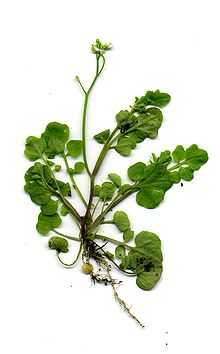Cardamine hirsuta
| Cardamine hirsuta | |
|---|---|
 | |
| Scientific classification | |
| Kingdom: | Plantae |
| (unranked): | Angiosperms |
| (unranked): | Eudicots |
| (unranked): | Rosids |
| Order: | Brassicales |
| Family: | Brassicaceae |
| Genus: | Cardamine |
| Species: | C. hirsuta |
| Binomial name | |
| Cardamine hirsuta L. | |
Hairy bittercress, Cardamine hirsuta, is an annual or biennial plant native to Europe and Asia, but also present in North America. The plant is a member of the mustard family (Brassicaceae), and is edible[1] as a bitter herb. It flowers from quite early in the Spring until the Autumn. The small white flowers are borne in a corymb on wiry green stems, soon followed by the seeds and often continuing to flower as the first seeds ripen. The seed are borne in siliquae which, as with many Brassica species, will often burst explosively when touched (explosive dehiscence), sending the seeds flying far from the parent plant. Seeds germinate in the Autumn, and the tiny plants are winter annual (green throughout the winter months).
This plant grows best in damp, recently disturbed soil. These conditions are prevalent in nursery or garden centre plants, and hairy bittercress seeds may be introduced with those plants. Once established, particularly in lawn areas, it is difficult to eradicate. The tiny flowers are attractive to a few early butterflies, including (in the United States) spring azure (Celastrina ladon) and falcate orange-tip (Anthocharis midea).
Description
This species grows to no more than 30 centimetres (12 in).[2] It is an annual plant and very similar to Cardamine flexuosa. The stems are hairless and the leaves do not clasp the stems, as in C.flexuosa. It has only 4 stamens and the fruits overtop the flowers.[3]
Names
Other common or country names include lamb's cress, land cress, hoary bitter cress, spring cress, flick weed, and shot weed (or lambscress, landcress, hoary bittercress, springcress, flickweed, and shotweed). As Old English stune, the plant is cited as one of the herbs invoked in the pagan Anglo-Saxon Nine Herbs Charm, recorded in the 10th century.
References
- ↑ Dennis Horn, David Duhl, Thomas Ellsworth Hemmerly & Tavia Cathcart (2005). Wildflowers of Tennessee, the Ohio Valley, and the Southern Appalachians: the official field guide of the Tennessee Native Plant Society. Edmonton: Lone Pine Publishers. p. 112. ISBN 978-1-55105-428-5.
- ↑ Clapham, A.R., Tutin, T.G. and Warburg, E.F. 1968. Excursion Flora of the British Isles. Cambridge. University Press. ISBN 0521046564
- ↑ Webb, D.A., Parnell, J. and Doogue, D. 1996. Dundalgan Press Ltd. ISBN 0852211317
External links
| Wikiversity has bloom time data for Cardamine hirsuta on the Bloom Clock |
| Wikibooks' A Wikimanual of Gardening has more about this subject: |
 Data related to Cardamine hirsuta at Wikispecies
Data related to Cardamine hirsuta at Wikispecies Media related to Cardamine hirsuta at Wikimedia Commons
Media related to Cardamine hirsuta at Wikimedia Commons- http://biology.burke.washington.edu/herbarium/imagecollection.php?Genus=Cardamine&Species=hirsuta
- http://www.itis.gov/servlet/SingleRpt/SingleRpt?search_topic=TSN&search_value=22797
- USDA Plant Profile: Cardamine hirsuta